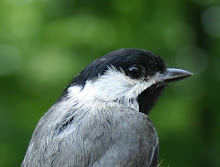To give you a bit of background information, several of the same people tend to attend the same bird conferences year after year and a regular conference attendee is a biologist who works on private property in the area I was planning to visit. He has been studying the Black-capped Vireo for the last 9 years. The Black-capped Vireo is an endangered bird and is pretty much endemic to the Hill Country region of Texas, located in the center of the state. This vireo prefers Shin-oak with a mixing of Texas Oak, Texas Red Bud and a small amount of Ashe Juniper. Ideally this habitat needs to be burned periodically to kill back the Ashe Juniper and to keep the Shin Oak at a reasonable height.

We began Monday morning right at dawn. The field biologist had his recording equipment with him and told me that right at dawn and for 20 minutes after, the males will sing continuously and this was known as their "dawn song". He recorded a dawn song and proceeded to point out the various songs and sounds of these birds over the course of the day. The vocal repertoire of these vireos was amazing and I was equally impressed with how well acquainted the biologist was with each scold, trill, bubble and song of these birds.
The biologist was looking to band one particular female bird he was observing over the last few weeks. He set up a net in her territory and used playbacks of alarmed birds and Screech Owls as a means to lure her and others in to the mist net. We not only captured the desired female Black-capped Vireo but also her mate, a Hermit Thrush, Orange-crowned Warbler and a gorgeous male Golden-cheeked Warbler.
Black-capped Vireo

After the birds were processed and photos taken, the biologist handed them off to me to examine and release. I know these capturing these birds are every day events for this biologist and his staff, but I was ecstatic to hold in my hands 2 endangered birds (the Golden-cheeked Warbler is also an endangered bird). The Black-capped Vireo is very difficult to find on public land in Austin because not many places are managing the habitat. Balcones Canyonlands National Wildlife Refuge however, is the exception and there are an estimated 30 breeding pairs on their property.
After mist netting we did a combination of checking existing nests and looking for new nests. Nest searching requires patience and skill. I learned the "scolding" sound the females make when she is separated from the male, especially during the nest-building period. The biologist was especially cued in to this scold and was usually able to quickly find the nest if he was in the vicinity of the female after she made the scolding sound. The male will also briefly sing as the female is actively building the nest. Obviously these birds sing after dawn, but the song is 5 or 10 minutes apart and he will not sit still. You may hear the bird at one location and 10 minutes later when he sings again, he will be in a completely different area. Once you hear the vireo and he is on the move, you must race through a thick tangle of scrub oak and ashe juniper, all the while dodging prickly pear cactus, poison ivy, maintaining your balance amidst the exposed, loose limestone rocks that are hidden in the grass to keep up with a bird that may be actively nest building, or simply foraging. If the bird is foraging, the process begins anew and you have to follow the same bird until he or she returns to the new nest. The nest is a mere 2-3 feet off the ground, usually hidden among the leaves in the heart of a shin oak.
Under the sun in the wilds of central Texas I also watched 2 Swainson's Hawks quarrel and wheel in the sky, watched a Sharp-shinned Hawk shoot across our heads, came across a Common Ground Dove sitting on her nest, admired Texas Mountain Laurel, Mexican Buckeye, Bluebonnets and a myriad of small yellow flowers.
It was an amazing day.

No comments:
Post a Comment